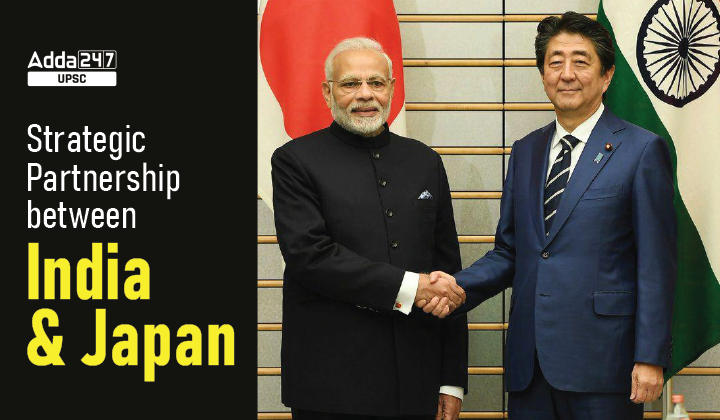Table of Contents
Strategic partnership between India and Japan- Relevance for UPSC Exam
General Studies III- International Relations.
In News
China’s growing military capabilities and assertiveness on territorial disputes are at the heart of the deteriorating environment of India and Japan.
The 2+2 talks between India and allies
- The 2+2 dialogue is a format of meeting of the foreign and defense ministers of India and its allies on strategic and security issues.
- A 2+2 ministerial dialogue enables the partners to better understand and appreciate each other’s strategic concerns and sensitivities taking into account political factors on both sides.
- This helps to build a stronger, more integrated strategic relationship in a rapidly changing global environment.
- India has 2+2 dialogues with four key strategic partners: US, Australia, Japan, and Russia.
Recent developments in India-Japan Relationship
- Recently India, Australia and Japan formally launched the Supply Chain Resilience Initiative. The initiative was launched to counter the dominance of China in the Global Supply Chain.
- It aims to prevent disruptions in the supply chain as seen during COVID-19 pandemic.
- The initiative will mainly focus on diversification of investment and digital technology adoption.
- The Act East Forum, established in 2017, aims to provide a platform for India-Japan collaboration under the rubric of India’s “Act East Policy” and Japan’s “Free and Open Indo-Pacific Vision”.
- At the Second meeting of the Act East forum, both sides agreed to focus on expanding of Japanese language in North East, training of caregivers under Technical Intern Training Program (TITP), capacity building in area of bamboo value chain development and Disaster Management.
- The inaugural India-Japan Space Dialogue was held in Delhi for enhancing bilateral cooperation in outer space and information exchange on the respective space policies.
- Japan and India have entered into a $75-billion currency swap arrangement that will bolster the country’s firepower as it battles a steep drop in the rupee’s value.
- A currency swap is an agreement between two parties to exchange a series of cash flows denominated in one currency for those denominated in another for a predetermined period of time.
- The deal will help the two countries to swap their currencies for U.S. dollars to stabilize the rupee which has witnessed the steepest fall in recent years.
Japan’s strategy
- Capacity building: To cope with Chinese power involves three broad elements reorienting Japan’s diplomacy, boosting national capabilities to deter aggression and deepening defense partnerships.
- Realism diplomacy: In his address to the annual Shangri La Dialogue in Singapore this June, Japanese PM Fumio Kishida talked of a new “realism diplomacy” that will allow Japan to meet the new security challenges through pragmatism and firmness.
- Increase in budget: On the question of deterrence, Kishida declared his commitment to “fundamentally reinforce Japan’s defense capabilities within the next five years and secure substantial increase of Japan’s defense budget needed to effect it”.
- No apology: Japan is no longer apologetic about its new determination to protect itself. For different reasons, both Tokyo and Delhi had tended to be far too deferential to China and hesitant to call out Beijing’s unacceptable actions.
Security and Defense cooperation
- QUAD: Formed in 2007 and revived in 2017 The Quadrilateral Security Dialogue (QSD, also known as the Quad) is an informal strategic dialogue between the United States, Japan, Australia and India.
- Exercise Malabar: The dialogue was paralleled by joint military exercises of an unprecedented scale, titled Exercise Malabar.
- JIMEX: In spite of the pandemic, complex exercises in all domains were conducted including Japan India maritime exercise (JIMEX 2020) and PASSEX, showcasing the trust and interoperability between the navies.
Challenges
- The two countries are too far apart to be meaningful partners in any confrontation between one of them and China.
- No partnership has the military muscle or diplomatic heft to achieve its objectives in countering China.
- At the diplomatic level, neither pulls the kind of power that can counter Beijing and this is not just because they are not UNSC members, unlike China.
- Japan obviously has a very advanced high-technology industrial sector, its military industry is insignificant. It’s better not to invoke the DRDO.
Way forward
- Although the Covid-19 situation remains challenging, people-to-people exchanges between two countries are also being advanced.
- Cooperation has also taken great strides in the area of security, including joint exercises between the Japan Self-Defense Forces and the Indian Armed Forces.
- Taking advantage of its considerable assets — the world’s third-largest economy, substantial high-tech skills, Japan is largely perceived as a natural ally to India.
- If Japan and India continue to add concrete security content to their relationship, their strategic partnership could potentially be a game-changer in Asia.
Conclusion
- Both should inject substantive military content into the strategic partnership between India and Japan. For there is much that Delhi and Tokyo could do together in meeting their common security challenges.




 TSPSC Group 1 Question Paper 2024, Downl...
TSPSC Group 1 Question Paper 2024, Downl...
 TSPSC Group 1 Answer key 2024 Out, Downl...
TSPSC Group 1 Answer key 2024 Out, Downl...
 UPSC Prelims 2024 Question Paper, Downlo...
UPSC Prelims 2024 Question Paper, Downlo...
